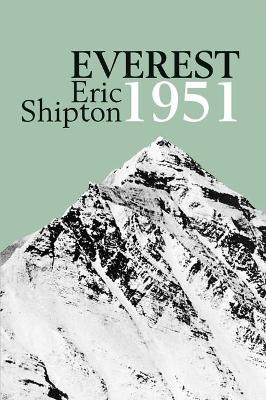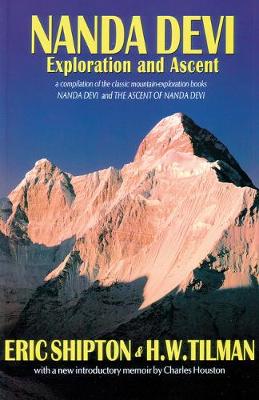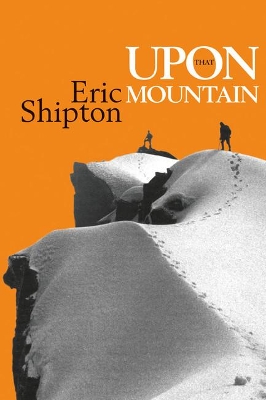Eric Shipton: The Mountain Travel Books
6 total works
'As I studied the maps, one thing about them captured my imagination - Across this blank space was written one challenging word, "Unexplored"'
In 1937 two of the twentieth century's greatest explorers set off to explore an unknown area of the Himalaya, the breath-taking Shaksgam mountains. With a team of surveyors and Sherpas, Eric Shipton and H.W. Tilman located and mapped the land around K2, the second-highest mountain in the world. It was their greatest venture, and one that paved the way for all future mountaineering in that area of the Himalaya. For Shipton and Tilman, exploration was everything, with a summit a welcome bonus, and Blank on the Map is the book that best captures their spirit of adventure.
With an observant eye and keen sense of humour, Shipton tells how the expedition entered the unknown Shaksgam mountains, crossing impenetrable gorges, huge rivers and endless snow fields. There's a very human element to Shipton's dealings with his Sherpa friends, and with his Balti porters, some of whom were helpful, while some were less so. The expedition uncovers traces of ancient cultures and visits vibrant modern civilisations living during the last days of the British Empire. Only when all supplies are exhausted, their clothes in tatters and all equipment lost do the men finally return home. A mountain exploration classic.
In 1953, Edmund Hillary and Tenzing Norgay reached the summit of Mount Everest. They climbed from the south, from Nepal, via the Khumbu Glacier – a route first pioneered in 1951 by a reconnaissance expedition led by Eric Shipton. Everest 1951 is the account of this expedition.
It was the first to approach the mountain from the south side, it pioneered a route through the Khumbu icefall and it was the expedition on which Hillary set foot on Everest for the first time. Everest 1951 is a short but vitally important read for anybody with any interest in mountaineering or in Everest. The 1951 Everest Expedition marked the public highpoint of Shipton's mountaineering fame. Key information was discovered and the foundations laid for future success. Despite this, Shipton's critics felt he had a 'lack of trust' and thus failed to match the urgent mood of the period.
Despite having been on more Everest expeditions than any man alive, he was 'eased' out of the crucial leadership role in 1953 and so missed the huge public acclaim given to Hillary, Tenzing Norgay and John Hunt after their historic success.
Land of Tempest reveals Eric Shipton at his best - writing with enthusiasm and humour about his explorations in Patagonia in the 1950s and 1960s.
He is an astute observer of nature and the human spirit, and this account of his travels is infused with with his own zest for discovery and the joy of camaraderie. Undaunted by hardship or by injury, Shipton and his team attempt to cross one of the great ice caps in Patagonia. It's impossible not to marvel at his determination, resilience and appetite for travel and adventure, be it climbing snow-clad mountains, or walking in forested foothills. Shipton takes a reader with him on his travels, and the often-inhospitable places he visits are a stark contrast to the warmth of the people he encounters.
Land of Tempest is essential reading for anyone who loves nature, mountains, climbing, adventure or simply the joy of discovering unknown places.
'When a man is conscious of the urge to explore, not all the arduous journeyings, the troubles that will beset him and the lack of material gains from his investigations will stop him.'
Nanda Devi is one of the most inaccessible mountains in the Himalaya. It is surrounded by a huge ring of peaks, among them some of the highest mountains in the Indian Himalaya. For fifty years the finest mountaineers of the early twentieth century had repeatedly tried and failed to reach the foot of the mountain.
Then, in 1934, Eric Shipton and H. W. Tilman found a way in. Their 1934 expedition is regarded as the epitome of adventurous mountain exploration. With their three tough and enthusiastic Sherpa companions Angtharkay, Kusang and Pasang, they solved the problem of access to the Nanda Devi Sanctuary. They crossed difficult cols, made first ascents and explored remote, uninhabited valleys, all of which is recounted in Shipton's wonderfully vivid Nanda Devi - a true evocation of Shipton's enduring spirit of adventure and one of the most inspirational travel books ever written.
Upon that Mountain is the first autobiography of the mountaineer and explorer Eric Shipton. In it, he describes all his pre-war climbing, including his Everest bids of the 1930s, and his second Karakoram survey in 1939, when he returned to Snow Lake to complete the mapping of the ranges flanking the Hispar and Choktoi glacier systems around the Ogre.
Crossing great swathes of the Himalaya, the book, like so many of Shipton's works, is both entertaining and an important addition to the mountain literature genre. It captures an important period in mountaineering history - that just before the Second World War - an ends on an elegiac note as Shipton describes his last evening at the starkly-beautiful snow lake, before he returns to a 'civilisation' about to embark on a cataclysmic war.
During the Second World War, and up until 1951, Shipton worked as consul general in Kunming and Kashgar in China, and as a diplomat in Hungary and Persia. In Mountains of Tartary, he describes his climbs and explorations that take him from the barren steppes of central Asia, to glass-clear lakes and forested slopes. Shipton and his party enjoy varying degrees of hospitality from the local people and occasionally potentially dangerous encounters. The book details the exploits of the climbers, explorers and guides, including a hilarious drunken banquet with government officials.
Mountains of Tartary is like a postcard from history - a must-read for any keen climber, walker or explorer.





